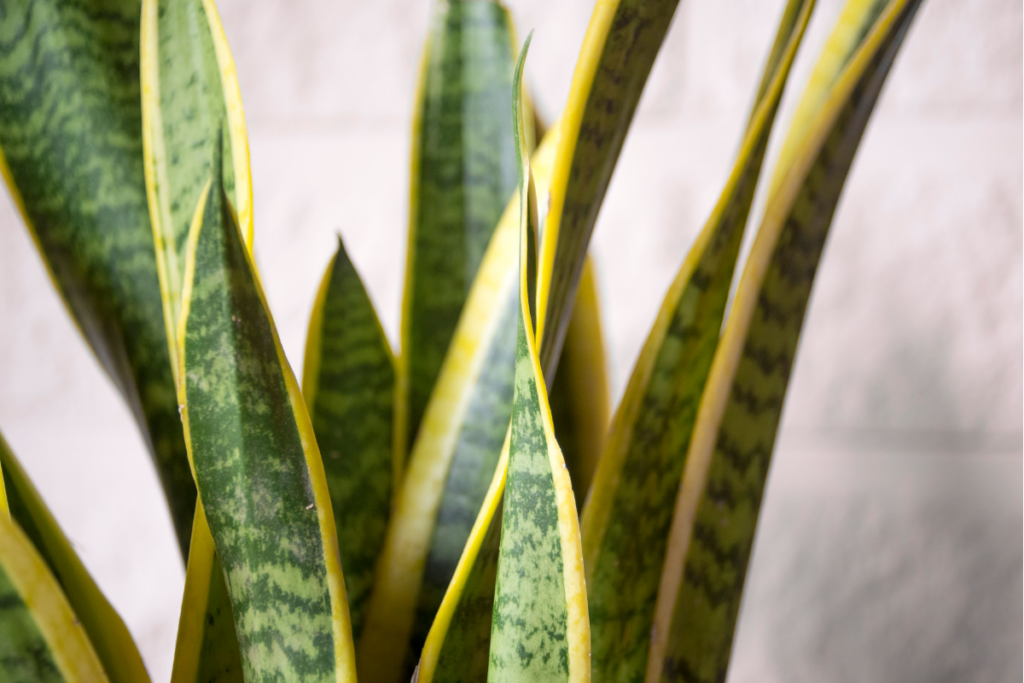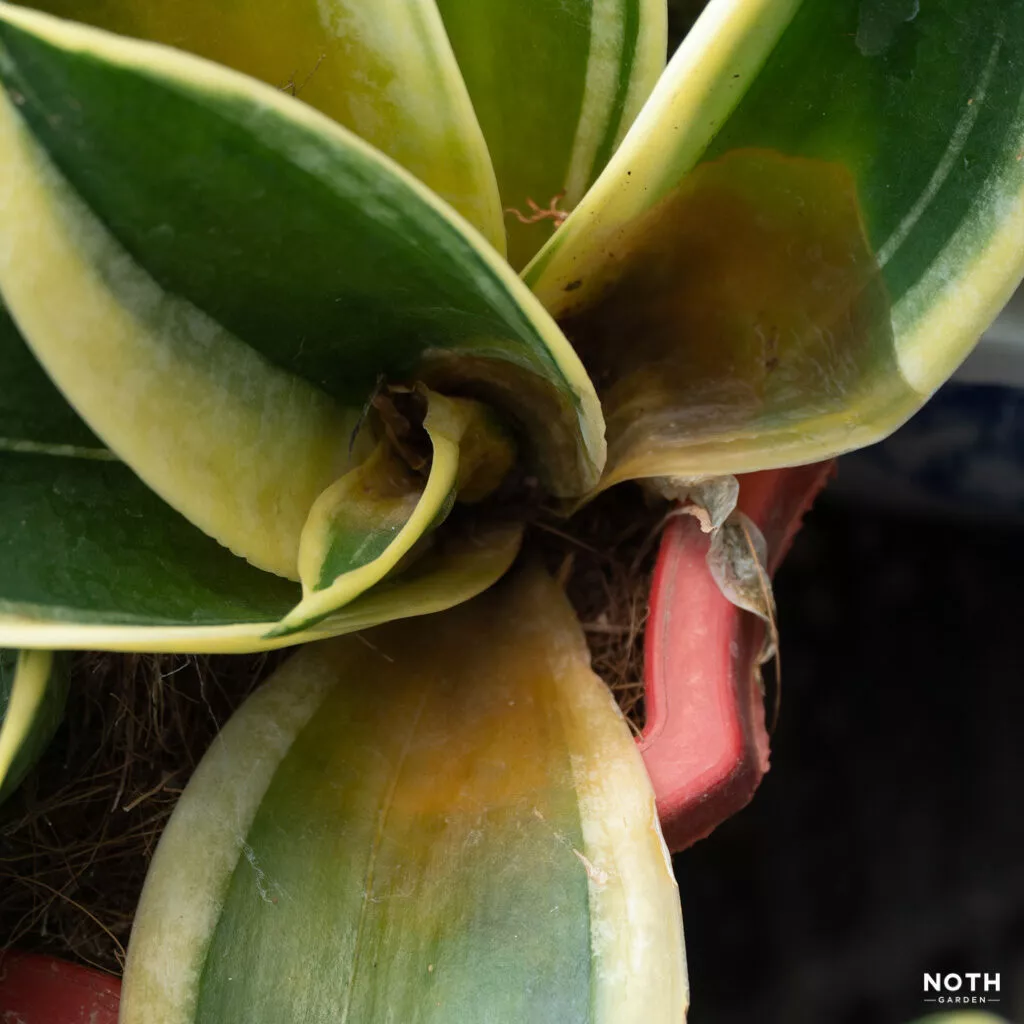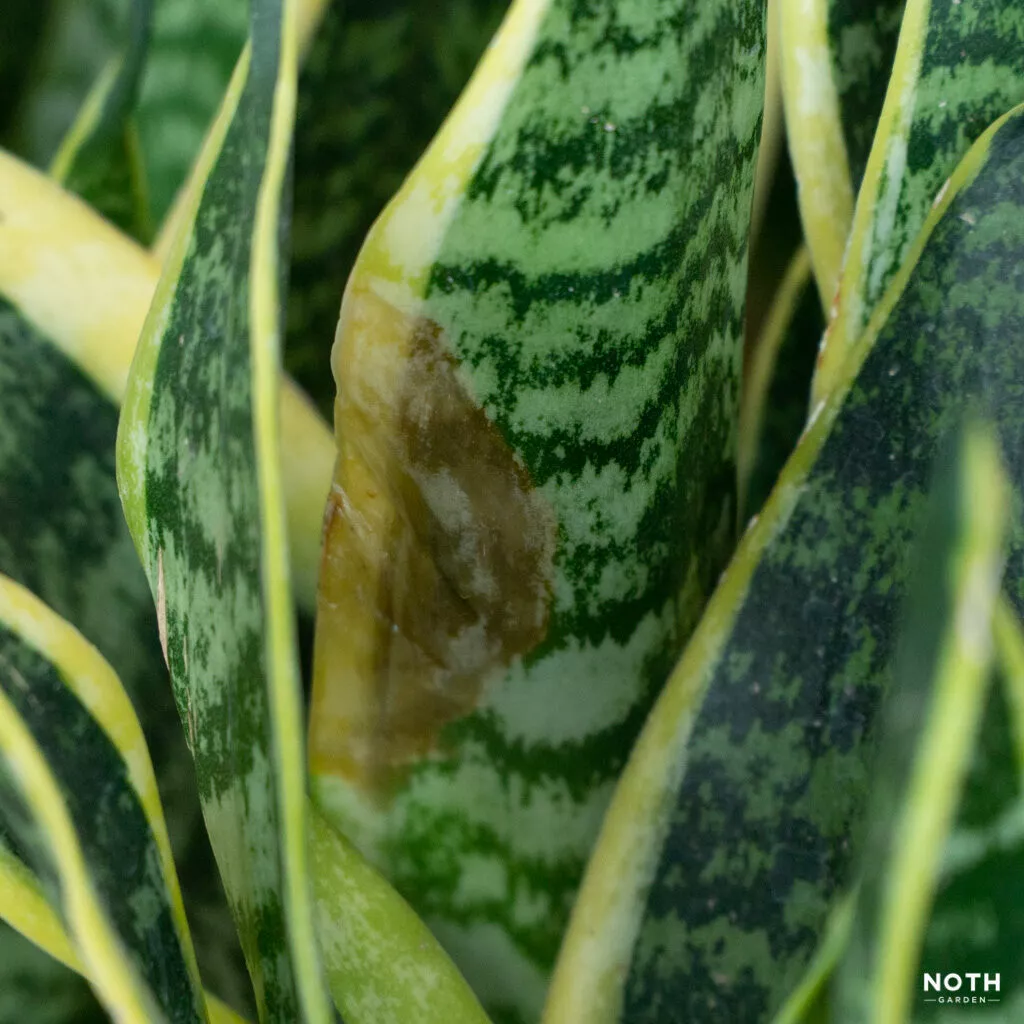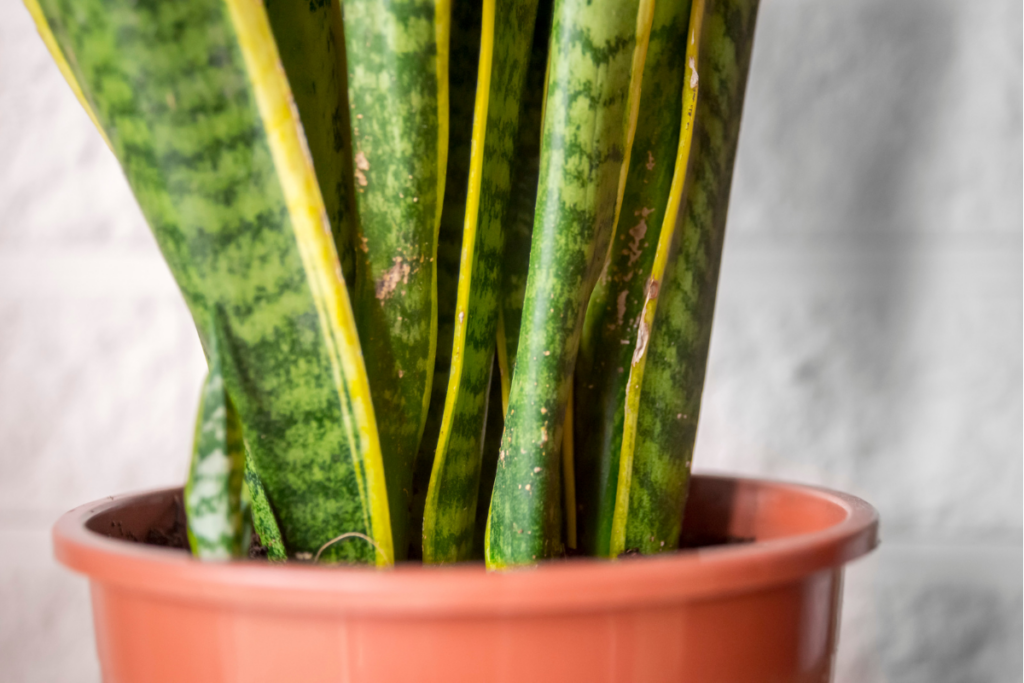Given that they can survive low light conditions, drought, and pest infestation, snake plants would be a strong contender for the title of the toughest indoor plant. However, the growth and appearance of plants may be negatively impacted by infections that even the toughest plants can get. Read and find out what causes brown spots on snake plant.

The leaf problem that snake plant is most commonly affected by are brown patches. The most frequent causes of leaf brown spots on Sansevieria plants are fungus, insects, and insufficient watering. This problem may get worse in conditions of intense sunlight, extreme cold, and excessive fertilizer usage.
In this article, we will discuss the main reasons of brown spot occurrence, simple solutions, and tips on keeping your lovely snake plant free of diseases.
What Are The Causes Of Snake Plants Brown Spots?

Your snake plant may get brown patches for a number of reasons. Improper watering or fungus problems are all symptoms of inadequate care.
Fungal Disease Snake Plants
Snake plants are readily susceptible to fungus-like red leaf spots, which form red to brown lesions on their leaves, and southern blight. A sticky, brownish fluid will start to exude from brown spots as they begin to soften and become mushy.
Bacterial leaf spots and rust are two more ailments that cause dark, wet areas on plant leaves.
Let’s examine the three fungi in more detail to see whether they are to blame for the browning of your snake plant’s leaves.
1. Red Leaf Spot
Red leaf spot is certainly to blame if ever you see crimson or red-brownish patches on your snake plant. High humidity and warm temperatures are two environmental elements that favor growth, development, and spread of this sickness.
2. Southern Blight
This disease that spreads via soil is brought on by the fungus Sclerotium rolfsii. The conditions that this fungus prefers are moist and warm. So, problems in drainage or overwatering may contribute to the spread of this disease.
Snake Plant roots begin to become brown and yellow as the Southern Blight attacks the root system. Your plant will die if you will not do anything about it.
3. Rust
Although snake plants may not be commonly affected by this, they may nevertheless cause brown patches on the plant leaves that resemble rust.
Heterobasidiomycetes subclass fungus attacks the living tissues of the plant, particularly the leaves, to produce rust. Since rust fungus does not consume decomposing organic matter, they easily move from plant to plant after draining the sap.
The first signs of Sansevieria plant rust typically appear on the plant leaves, and if they are not treated right enough, the whole plant might die.
RELATED: Snake Plant Root Rot: Crucial Steps to Fix Root Rot Problem and More!
How To Avoid Snake Plant Fungal Diseases?

Make sure your beloved snake plant has enough ventilation surrounding it, and look for fungal problems in any new plants you bring to your home.
The following are some examples of treatments of fungal infections:
Southern Blight Treatment
You may halt the decomposition of your Snake plant leaves by application of fungicides and utilizing heat treatment (solarization) to fight southern blight. However, a plant fungus or bacterium, that Snake Plants are easily affected to, spreads and reproduces fast when the environment is wet. Therefore, water the soil only and always aim to avoid getting any water on plant leaves.
Red Leaf Spot Treatment
Trim the impacted leaves as a cure to avoid the red-brownish spots from spreading to other parts of the plant or to the entire plant. Make careful to get rid of any fungus-infected areas on your snake plant to halt it from ever spreading and causing more serious damage.
Fungicides that have sulfur and copper properties may be used on the plant as a prophylactic measure.
Rust Removal
Rusts may be handled similarly to red leaf marks by removing the affected parts. Also, you should remove any infected leaves that are left on the ground and limit your contact with water to avoid the rust from spreading further.
Bacterial Leaf Spot Treatment
This sickness is caused by Xanthomonas spp. Or Pseudomonas spp. and shows symptoms as water-soaked regions that ultimately become brown. For this illness, there is not yet an authorized pharmaceutical treatment. The best treatment as of right now is mechanical therapy or total removal of afflicted regions.
It is advisable to use care while watering sick plants since the disease may spread via water splashes and wet air.
RELATED: Snake Plant Flowering: Important Tips To Get Your Sansevieria to Bloom and More!
Pests Infestation
An infestation of pests is just as harmful to the health of your snake plant. The snake plant is preferred by a number of bug species over other types of house plants. These are spider mites and mealybugs.
The Tetranychidae family includes more than 1,200 distinct species of spider mites. They like hiding within a plant’s leaves.
The size of a snake plant’s leaves makes them the ideal habitat for spider mites. The average spider mite is 0.04 inches long, thus, a lot of them can assemble at once on the snake plant.
How Can You Detect if There Is An Infestation Of Spider Mites?
Spider mites will first weave a web beneath the leaves of your snake plant. Once everyone has settled in, they begin to consume the snake plant’s cells and extract the sap from within. Brown stains can be left in the trail of spider mites in any location where they decide to graze.
The second simplest way to identify spider mites is by looking attentively at the underside of the leaves for their webs, which can be seen in addition to the evident gnaw holes in the snake plant leaves that are marked in brown.
How Can You Detect Whether There Is An Infestation Of Mealybugs?
The snake plant’s other adversary is mealybugs. Mealybugs are scale insects without armor that favor warm environments and are members of the Pseudococcidae family.
Be careful since they will also happily consume all the liquids from your snake plant and some other houseplants. Once more, obvious brown stains will show mealybug infestation.
Mealybugs can also result in the spread of illnesses that could kill your snake plant, which is another major problem.
How To Avoid Snake Plant Pest Problems?

The easiest strategy to prevent pests is to constantly look for symptoms of infestation on the leaves. In order to reduce the risk of infecting other plants, it is preferable to remove the plant if it is already badly ill. Among the most common methods to get rid of pests in your snake plants include using organic or synthetic pest control and washing them off.
Several natural pest control methods, such as the following, are simple to discover in your home:
Soapy Water Mixture
This water and dish soap mixture may be used to dry out aphids and spider mites. This solution, which is created by combining four cups water with 5 teaspoons of dish detergent, should be sprayed on the damaged plant or plant parts.
Neem Oil Organic Spray
This organic fungicide and insecticide are made from neem tree seeds, which originated in India. Aphids, scales, mites, and other small insects may all be gotten rid of using it.
Alcohol Mist
This treatment effectively deters insects from indoor plants. To prepare this solution, mix one or two cups of isopropyl alcohol and one-third cup of water. Put this mixture into a spray bottle for easy application.
Inconsistent Routine Of Watering
Inconsistent watering may also cause snake plant foliage to develop black tips or patches. Included in this problem are both overwatering and underwatering. Overwatering is a concern while caring for snake plants, as you may be aware. It may cause root rot and plant damage.
Early root rot detection on your snake plant may be treated by relocating it. You may do any of the following:
- To repot your plant, use perlite, peat moss, grit, or coarse sand mixture as fresh soil.
- While aiming to salvage as many fresh and healthy leaves as possible, just clip the rotting ends of your leaves.
- Gently incorporate the cut foliage into the fresh soil, then place it in full sunlight. Remember to keep the plant soil wet but not drenched.
Additionally, this kind of plant often experiences underwatering because of its well-known water-saving characteristics, which are almost comparable to those of cactus plants. When buried, snake plants may suffer from severe dehydration and display symptoms like browning foliage.
How To Address Problems Of Inconsistent Watering?
Among the easiest ways to give water to your snake plant effectively is to keep a schedule and check to see whether it needs watering or if any other plant issues are developing.
To prevent watering the leaves, it’s crucial to just water the potting soil of your snake plant. If water spills on the plant leaves, they can become vulnerable to a fungal infection. Additionally, a fungal infection is one of the leading reasons for the brown blotches on your snake plants.
Read more about the proper watering of your Snake Plants if you are uncertain about the amount of water your snake plant requires.
Using Tap Water
Given that Sansevieria plants are highly sensitive plants, the kind of water you use to hydrate them is important.
Chlorine, a substance often present in tap or city water, ensures that the water is truly safe for consumption of humans. However, this poison makes snake plants sensitive, causing them to show obvious signs of stress.
The availability of nutrients will change depending on how much chlorine is in the potting soil. Lack of potassium (K) may be causing brown spots in snake plants. It is essential to give your snake plant chlorine-free or filtered water as a result.
How To Solve Problems With Unfiltered Water?
The easiest and most common remedy for this is to filter the water using a regular water filtration device you have access to.
Before using the water to hydrate your plant, you might also let it rest in the sun for a whole day. You may already be aware of how well sunlight eliminates chlorine, because sunlight has the potential to destroy 90% of chlorine in only two hours.
Too Much Sunlight
Even without much sunlight, snake plants may persist. Because of this, it’s also among the best options for indoor plants.
If your lovely snake plant is exposed to too much sunlight, the leaves can develop brown spots and a burnt foliage. In this particular case, your Sansevieria plant uses more energy than it can manage. Brown spot symptoms and, ultimately, leaf tissue destruction, are the outcomes of this.
How To Address Issues With Too Much Sunlight?
If your Sansevieria plant is not acclimatized to a specific level of light intensity exposure, a gradual modification of the heat and light settings might help it adapt. Keep your plant away from the sun’s direct rays as much as possible. Keep in mind that it thrives in filtered, indirect sunlight without any issues.
The best technique to guarantee a healthy Sansevieria plant free of brown spots is still to determine the ideal lighting conditions for your Snake Plant.
Damage Due To Cold
Sansevieria are less hardy in colder climates. Leaving them someplace when it may become colder than 55°F or 12°C can be upsetting for them. If your snake plant is exposed to freezing temperatures, the liquids found in your plant’s leaf cells, or cell sap, will eventually freeze.
As you are aware, when water freezes, its volume increases. As a result, the plant cell membrane rips, ultimately causing cell death. Infections caused by bacteria and fungi are possible in this setting. The harmed portion of your snake plant’s leaves will consequently have brown stains.
Extreme cold may also be harmful to the plant’s root system because the water has the capability to freeze. Brown spots start to appear on the leaves as a result of the roots’ incapability to absorb enough nutrients.
How To Avoid Cold Damage Problems?
Ensure to keep your hardy snake plants out of temperatures below 55°F to decrease the risk of damage caused by cold environment. During the day, keep your plants between 65 and 80 °F, and at night, between 55 and 70 °F. In addition, you may expose them to a lot of sunlight in the summer and keep them indoors in the winter and autumn.
RELATED: Snake Plant Soil Requirements: The Best Soil Type For Your Snake Plants and More!
Excessive Fertilizer
Because of their hardiness, snake plants may survive without fertilizer. However, too much fertilizer might harm your plant and cause fertilizer burn, which appears as brown spots on the foliage. In addition, too much fertilizer may raise the levels of salt and nitrate, which will have the effect of burning the leaves.
How To Address Excessive Fertilizer Problems?
You should aim to fertilize your gorgeous snake plant in the summer and spring. A potted Sansevieria plant only needs a small amount of fertilizer throughout the growing period.
Therefore, take care not to overuse it. Before you apply fertilizer, always read the packaging guidelines for exact measurements. If ever you unintentionally added a little extra fertilizer, you may flush it out by running a lot of water to the soil.
For a healthy indoor plant to thrive, slow-releasing fertilizers like organic or compost give more naturally existing plant nutrients. It gradually degrades into little amounts over a prolonged period of time. The majority of this type of fertilizer just needs one application and may last four months.
It’s important to keep in mind that fertilizing during the winter, when snake plants are dormant, might be harmful. So instead, apply a little quantity of worm compost to the soil in the pot where your snake plant is growing.
Low Humidity Level
Snake plants need minimal watering, thus, they don’t require a lot of humidity. However, a severe lack of humidity causes plant leaves to lose excessive amounts of water, which is a significant cause of the brown areas on your snake plants.
How To Avoid Low Humidity Problems?
To achieve the necessary amounts of humidity, keep the relative humidity at around 40%. You may also use instruments, such as a humidifier or a digital hygrometer, to observe the air humidity surrounding your plants.
Additionally, you may assemble a pebble tray to create your DIY humidifier. To make one, you will be needing a tray, some stones, and sterile water. After placing the stones on the tray, add water. The rocks just need a little amount of water to get moist.
You may now set your plant on your DIY pebble tray. This method will raise humidity by gently emptying the water surrounding the plant via evaporation.
Frequently Asked Questions
Should I use a ready-made mixture or a DIY one?
When you need to treat your plant, there is no set prescription that you must follow. They are both good to deal with. Either, you need to be really careful about it since using chemicals on your plants excessively might only result in plant burns.
What do the brown spots on the leaves of snake plants look like?
Generally speaking, brown spots on a plant resemble lesions or circles on the surface of the leaf. However, they come in a variety of sizes and forms as well.
Should I trim the browning tips on the leaves of my snake plant?
Using a good pair of scissors, find the plant’s brown tips, and then cut them off. Instead of removing the entire snake plant stems, feel free to only clip the tops or margins of the leaves. Avoid beginning to pull or shred the brown portion because doing so would also harm the healthy portions.
Final Thoughts
As you can see, the bulk of factors that contribute to brown spots on snake plants have a direct correlation with how well these plants are cared for. With the correct care and attention, your favorite snake plant will grow swiftly. After all, they are the most carefree indoor plants.
Editor’s Recommendations
Top 18 Rare Snake Plants You Must Have
Snake Plants Growth: How Big Do Sansevierias Grow?
Growing Snake Plants Outside: Can They Thrive Outdoors? Answers and More!







